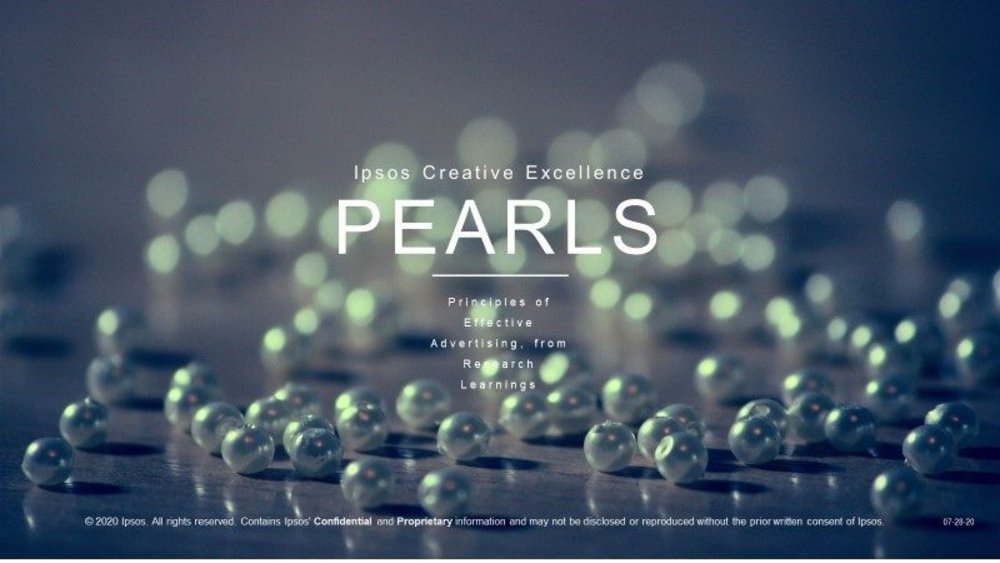Promoted content
PEARLS of wisdom /
Ipsos’ SVP of creative excellence appeared at Contagious’ USA Summer Bootcamp to share some research-based insights into current trends
Phoebe O’Connell
/
Ispos is one of the biggest research companies in the world, and its SVP of creative excellence, Pedr Howard, has had a career spanning all aspects of advertising research. Howard joined Contagious at this year’s USA Summer Bootcamp to give a preview of Ipsos’ evidence-based look at current trends for creative executions, and to share learnings on what levers are available to create more effective advertising.
Ipsos has been working on a project called PEARLS – Principles of effective advertising, based on research learnings. ‘We started with the analysis of just over 2,000 video ads,’ explained Howard. ‘We looked at the creative variables that went into them, the levers that creative agencies and teams can use [to put] together those commercials in the first place.’ The team then cross-referenced this data against the Ipsos US communication testing database. The data doesn’t end there – Howard and the team at Ipsos then integrated the findings with its brand health tracking database to see what works for different brands, eg. a challenger brand vs a leading brand.
Then the project went through a filter of data science and analytics that helped the team piece together their findings and present marketers and evidence with an evidence-based view of different creative strategies, said Howard. He stressed, ‘the way that we look at our advertising is very much on an evidence-based observation approach’ utilising three key metrics.
The first of these metrics is visibility: ‘We expose the ads in a clutter wheel to consumers in a distracted exposure,’ said Howard. ‘And then we see if people can remember the ad or not.’ Next is ‘brand link’ – ‘of those people who can remember the ad, can they spontaneously link it to the brand in question or not?’ Then there is behaviour change. ‘When we think about the impact that a brand can have we think about this in terms of behaviour change and brand relationship,’ explained Howard. The former is about short-term effects (like purchase intention, frequency, choice), while the latter is more long-term, to do with emotional associations with the brand.
Pedr Howard, Ipsos
Howard had begun his talk with a disclaimer: ‘These are absolutely not commandments to live by – if there’s one thing we’ve learnt about creative over the years it’s that some of the great ads break the rules.’ The point of PEARLS is to establish some guidelines that set agencies up for success. ‘And there are certain things that make that success more difficult,’ said Howard. For example, in terms of visibility, the average ad has a 33% chance of falling in the top third of the database. We live in a distraction-rich, attention-poor world, and ads that include drama, humour and conversation are much more likely to grab people’s attention.
‘Tell a story,’ advised Howard. ‘Humans remember stories. Stories are a way of getting people to listen and understand certain things. [...] If you can tell a real story to people, you’re going to get higher breakthrough scores [...] and be recognised in market.’ Individually, drama, humour, and conversation don’t make much difference – the power is in the pairings. That’s when you’ll see ad memorability boosted, said Howard.
Pedr Howard, Ipsos
Conversely, ads with a high scene count and continuous voice-over are significantly less likely to perform well and be memorable, up to six times lower than the story-based ads. Based on eye-tracking research, higher scene counts are linked to confusion, ‘and the reality is that viewers don’t want to work hard to uncode advertising,’ explained Howard. But there are exceptions – 8% of such ads succeed in getting high breakthrough scores. ‘Just be aware,’ said Howard. If you have a high scene count, maybe think about ways to compensate for that potential cause of confusion.
When it comes to brand linkage, Ipsos’ research found that distinctive assets outperformed brand mentions or logos. The barrage of recent Covid-19 comms, for example, showed a lack of distinctive messaging or assets that left many people with no impression of which ads came from which brands. Distinctive assets can be anything that is not the brand logo – colours, characters, storylines. With distinctive brand assets, said Howard, ‘you’re free to be more creative, without having to shoehorn the brand in.’
When it comes to behaviour change, Ipsos’ research concludes that it’s best to think long-term, particularly with video assets. ‘Even if your objective is short-term sales,’ said Howard. Ads with both short-term product emphasis and long-term brand building outperform short-term sales-focused ads. He also explained the importance of realistic expectations for digital videos. While digital videos can be very effective at driving branded impressions, they are less impactful in terms of short-term sales impact.
Ipsos also looked at ‘that sea of sameness’ of Covid ads and identified the top performer: Budweiser’s updated ‘Wassup’ ad ‘didn’t follow the mould of the more sombre, serious [ads], it had a more lighthearted take on it, it told a story with characters, in their distinctive creative style,’ Howard explained.
To conclude, he reiterated the PEARLS of wisdom:
Tell stories
Use distinctive assets
Think long-term
Be realistic with digital video
Want more of the same? /
We don’t just write about best-in-class campaigns, interviews and trends. Our Members also receive access to briefings, online training, webinars, live events and much more.




